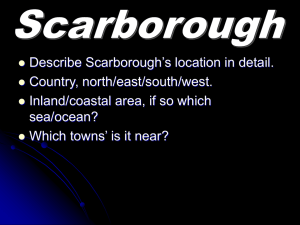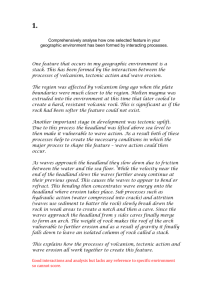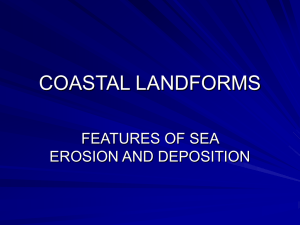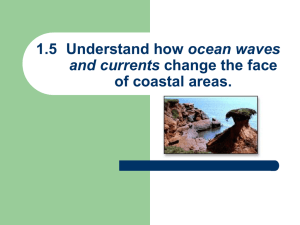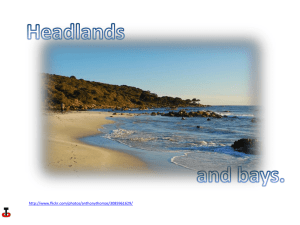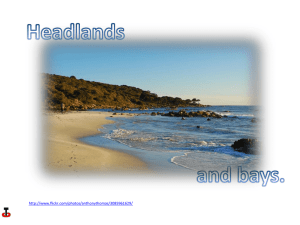Comprehensively analyse how your named natural feature has
advertisement
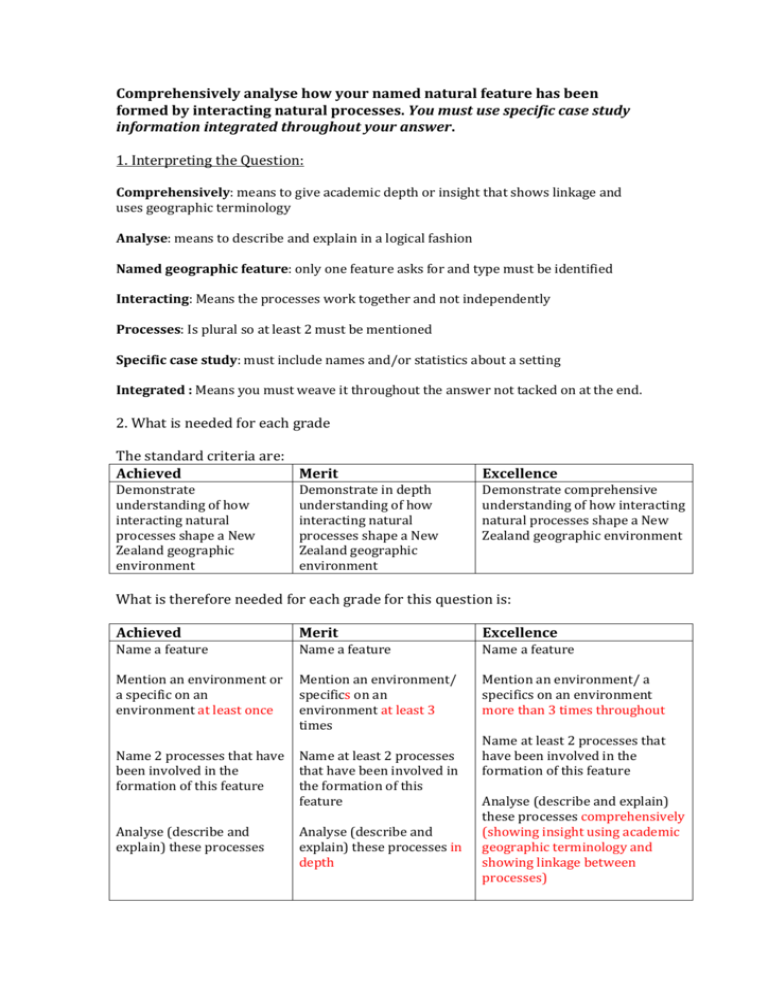
Comprehensively analyse how your named natural feature has been formed by interacting natural processes. You must use specific case study information integrated throughout your answer. 1. Interpreting the Question: Comprehensively: means to give academic depth or insight that shows linkage and uses geographic terminology Analyse: means to describe and explain in a logical fashion Named geographic feature: only one feature asks for and type must be identified Interacting: Means the processes work together and not independently Processes: Is plural so at least 2 must be mentioned Specific case study: must include names and/or statistics about a setting Integrated : Means you must weave it throughout the answer not tacked on at the end. 2. What is needed for each grade The standard criteria are: Achieved Merit Demonstrate understanding of how interacting natural processes shape a New Zealand geographic environment Demonstrate in depth understanding of how interacting natural processes shape a New Zealand geographic environment Excellence Demonstrate comprehensive understanding of how interacting natural processes shape a New Zealand geographic environment What is therefore needed for each grade for this question is: Achieved Merit Excellence Name a feature Name a feature Name a feature Mention an environment or a specific on an environment at least once Mention an environment/ specifics on an environment at least 3 times Mention an environment/ a specifics on an environment more than 3 times throughout Name 2 processes that have been involved in the formation of this feature Name at least 2 processes that have been involved in the formation of this feature Analyse (describe and explain) these processes Analyse (describe and explain) these processes in depth Name at least 2 processes that have been involved in the formation of this feature Analyse (describe and explain) these processes comprehensively (showing insight using academic geographic terminology and showing linkage between processes) (The following examples have been simplified to get the point across – it is expected that the describe part is provided in a diagram showing the characteristics of the feature or its location) NOT ACHIEVED (N1) A cave is formed when waves crash onto the headland and form a hole in the rock or cave. Over time this gets bigger. Comment: Has not reached the Achieved criteria because no specific environment is mentioned, no process is included and no explanation for why the hole came to be there is included. NOT ACHIEVED (N2) At Muriwai caves are formed when the waves hit the headland and wave erosion uses sediment to batter against the rock to create a cave. Comment: Is partially achieved as includes a name that links it to a specific environment, names a process and gives a reason for that process. However, since only one process is named and explained it does not fulfill the requirement for achievement. ACHIEVED (A3) Caves are formed when waves approach the headland and bend due to wave refraction. This then concentrates the waves on the end of the headland where wave erosion batters the rock and then results in the formation of a cave eg on Otakamiro point. Comment: This just reaches achievement as fulfills the basic criteria required. That is a specific is mentioned that links it to an environment, two processes (wave refraction and wave erosion) are named with a brief explanation. It is limited by the brief explanation involved , only mentioning the environment once and due to the case study being tacked on the end rather than used in context. ACHIEVED (A4) The cave on Otakamiro headland is formed when waves from the Tasman approach the headland. Because of wave refraction the waves slow down and bend so that they are concentrated on the headland. Pieces of rock carried in the waves are then hurled at the rock and break it down by corrasion to create a cave. Comment: This meets the criteria better. There are two clearly named processes (wave refraction and corrasion), an explanation is clear for each and it includes specific case study information within the text. It falls short of a merit due to the depth of the explanation of the processes and only two pieces of specific case study information being provided. MERIT (M5) Caves are found on Otakamiro headland at Muriwai which are formed by the sub-processes of wave action including wave refraction and corrasion. The waves at Muriwai average 2m because of the strong prevailing wind and long fetch across the Tasman. When they get to Otakamiro headland they bend or refract onto the headland itself. When they reach the headland sediment held in the waves batter the hard rock and break it down until a small hole is formed in weak points just above the high water mark. This is known as corrasion. Over time this hole will expand to form a cave. Comment: This answer shows much more structure in that the opening sentence sets the scene by identifying the feature, the environment and the processes involved. It has the depth of explanation of the second process of corrosion to allow merit. It also has at least 3 specifics on the case study integrated into the answer. It falls short of a M6 as one of the processes is not explained in depth but is enough to gain achieved. MERIT (M6) Caves are found on Otakamiro headland at Muriwai due to the sub-processes of wave action such as wave refraction and corrasion. The waves are high energy, formed due to the strong prevailing winds that blow over 11knots 40% of the time and the long fetch of 2,000km across the Tasman. When these waves reach shallow water just off Otakamiro headland they slow down and bend or refract so they hit the end of the headland. Here the processes of wave erosion occur. Sediment in the waves is used to batter the hard, resistant Manukau breccia rock. The rock is also broken down when seawater dissolves chemicals in the rock and make it weaker. In this way cracks that occur in the rock are widened over time. Eventually these will form a cave such as that found on the northern end of Otakamiro point. Comment: This answer has good depth of both named processes to allow merit. It also uses a lot of specific case study information. What it lacks to take to the next level is any indication of the linkage between the processes. EXCELLENCE (E7) One natural feature that occurs at the South Muriwai Coastal Environment (SMCE) is the cave that occurs on the Northern side of Otakamiro point. This cave is formed by several processes that work together of which volcanism, faulting and wave action are the most important. 17 million years ago submarine volcanoes erupted and the volcanic lava mixed with the sedimentary rock present to form a resistant conglomerate called Manukau breccias. Then 10,000 years ago faulting uplifted this rock above sea level to form the Otakamiro headland. This can then be affected by wave action. Muriwai experiences high energy waves due to the strong prevailing SW winds and fetch of over 2,000km across the Tasman. When they approach the headland they slow down and refract so that the energy is then concentrated onto the headland. When they hit the headland the rock is eroded by sub-processes such as corrosion, corrosion and hydraulic action. Hydraulic action is when water is forced into a crack and pressure differences cause the crack to widen. In this way weak parts of the headland are eroded to create a hole and eventually a cave. Comment: This answer meets the criteria for excellence. A feature is clearly named, the environment is mentioned using specific information throughout and more than 2 processes are discussed. It uses good geographic terminology such as referring to the transfer of energy in the system and terms like ‘resistant conglomerate’ and ‘pressure differentials”. What it is not so strong on is the linkage between processes. This is inferred by mentioning a process as ‘the most important’ and ‘this can then be affected by wave action”. Because of this it remains as an E7. EXCELLENCE (E8) One natural feature that occurs at the South Muriwai Coastal Environment (SMCE) is the cave that occurs on the Northern side of Otakamiro point. This has been formed by several interacting processes which do not act alone but work together to create the feature. The first important process is tectonic action. Volcanic activity 17 million years ago was responsible for the hard volcanic conglomerate or Maukau breccia of which Otakamiro headland is composed and is the reason it is resistant to the waves and able to form distinctive features such as a cave. Tectonic action also lifted the headland above sea level 10,000 years ago making it now vulnerable to subsequent wave action. Wave action now forms the most significant process in creating the cave. Muriwai experiences waves that average 2m high and contain a lot of energy due to the strong prevailing SW winds and a fetch of 2,000km across the Tasman. As they approach the headland the wave velocity slows down as they hit shallow water. At the same time waves further from the headland continue at their former speed. This causes the waves to bend or refract so that their energy is now concentrated on the end of the headland. When the waves hit the headland the energy is used in the middle scale process of wave erosion. This takes many forms such as corrasion (sediment carried in the waves being hurled at the resistant Manukau breccia) and corrosion (the chemical breakdown of soluble minerals by the seawater). The most important of these small scale processes is hydraulic action in which water is forced into a crack and then expands due to pressure differentials and forces the crack apart. Together these sub-processes act on weaker points of the headland until a cave, such as that found on the northern end of Otakamiro headland, forms. Comment: This is a good answer possessing all the attributes of the E7 but adding to the linkage mentioned. Here the role played by each process in the formation of the feature is clear. Again it is an academic answer added to by clear understanding of the different scale of the processes involved. This gives it clear ‘insight’ or the wow factor.
